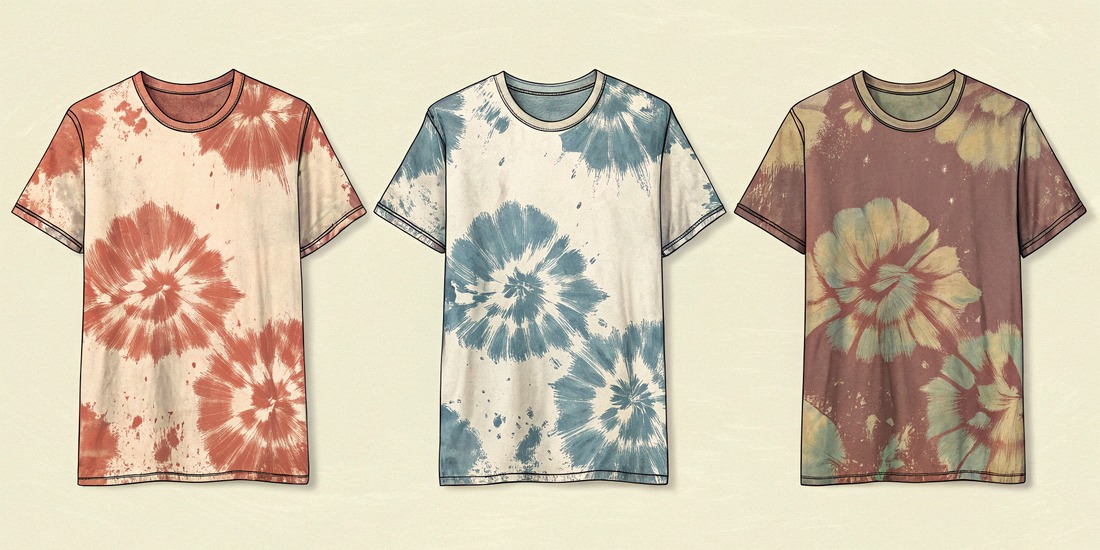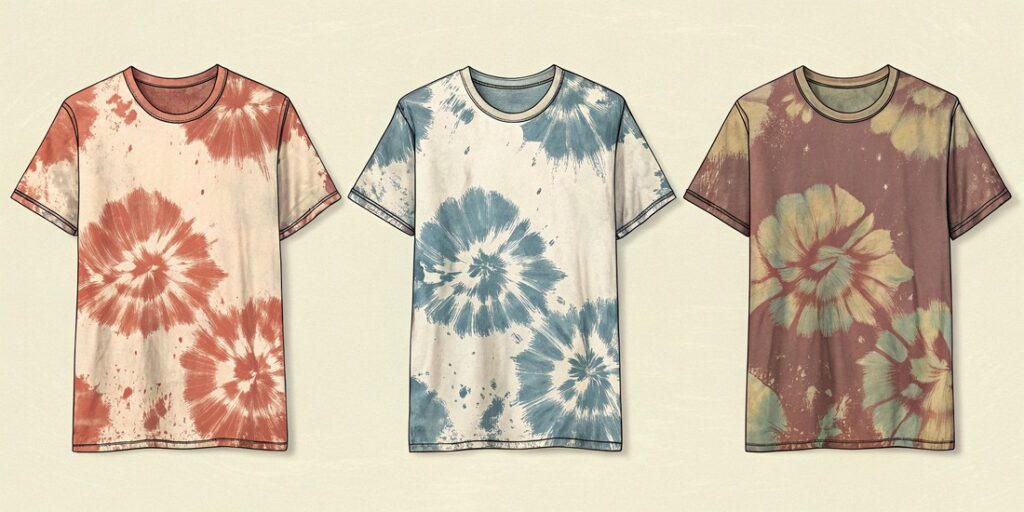LATEST NEWS
How to Get a Vintage Look Tie-Dye and Distressed T-Shirts
How to Get a Vintage Look Tie-Dye and Distressed T-Shirts

Vintage fashion continues to captivate style enthusiasts who appreciate the authentic, lived-in aesthetic that only time can create. Vintage tie-dye t-shirts represent the perfect blend of artistic expression and retro charm, offering a unique way to stand out while honoring classic fashion trends. Whether you’re looking to recreate the free-spirited styles of the 1960s or achieve that perfectly imperfect distressed look, the right techniques can transform any plain shirt into a vintage masterpiece.
Creating authentic vintage looks requires understanding the history and techniques that made these styles iconic. From the psychedelic patterns of classic tie-dye to the carefully crafted wear patterns of distressed denim, each vintage style tells a story. For inspiration on different vintage approaches, explore our vintage and retro t-shirt guide or check out our comprehensive retro style collection for ideas that blend nostalgia with modern appeal.
Ready to create your vintage masterpiece? Browse our Vibrant Horizons collection for the perfect base shirts to transform with your vintage techniques!
Understanding Vintage Aesthetics
The appeal of vintage tie-dye t-shirts lies in their authentic imperfections and the story they tell through wear patterns and faded colors. True vintage pieces carry the marks of time: slightly faded hues, soft fabric texture, and subtle signs of use that create character. Understanding these elements helps create convincing reproductions that capture the essence of genuine vintage clothing.
Authentic vintage pieces often feature specific color palettes that reflect the dyeing techniques and materials available during different eras. The 1960s and 1970s tie-dye movement favored bold, psychedelic colors that have since mellowed with age. Modern vintage tie-dye t-shirts should aim to recreate not just the original vibrancy but also the subtle fading that occurs over decades of wear and washing.
The distressed graphic tee aesthetic draws inspiration from band merchandise, vintage sports wear, and classic advertising shirts that have survived decades of use. These pieces often feature cracked graphics, faded lettering, and strategic wear patterns around seams and high-stress areas. The key to successful distressing lies in understanding how clothing naturally ages and replicating those patterns convincingly.
Fabric selection plays a crucial role in achieving authentic vintage looks. Natural fibers like cotton age more believably than synthetic blends, developing the soft hand feel and subtle color changes that characterize genuine vintage clothing. The weight and weave of the fabric also affect how distressing techniques will appear on the finished piece.
Essential Materials and Tools
Creating professional-quality vintage tie-dye t-shirts requires specific materials and tools that ensure consistent, lasting results. High-quality fabric dyes designed for natural fibers provide the best color saturation and longevity. Fiber-reactive dyes work particularly well for tie-dye projects because they bond permanently with cotton fibers, creating colors that won’t wash out over time.
Basic tie-dye supplies include rubber gloves, plastic squeeze bottles, rubber bands or string for binding, and a work surface that can handle spills. Soda ash serves as a crucial pre-treatment that helps dyes bond with fabric fibers. Without proper preparation, even the best dyes will produce disappointing, washed-out results.
Distressing tools for creating the perfect distressed graphic tee vary depending on the desired effect. Sandpaper in various grits helps create subtle wear patterns, while cheese graters and pumice stones produce more dramatic distressing. Razor blades and craft knives allow for precise cuts and strategic holes, but require careful handling to avoid injury.
Safety equipment should never be overlooked when working with dyes and distressing tools. Dust masks protect against inhaling particles during sanding, while eye protection prevents accidents when using sharp tools. Working in well-ventilated areas helps avoid exposure to dye fumes and dust.
Shopping List for Vintage Projects
- 100% cotton t-shirts in light colors
- Fiber-reactive dyes in vintage color palettes
- Soda ash for pre-treatment
- Rubber bands and string for binding
- Sandpaper in multiple grits
- Protective equipment and work supplies
Classic Tie-Dye Techniques
The spiral pattern remains the most recognizable design in vintage tie-dye t-shirts, creating the iconic swirling colors that defined the psychedelic era. Creating a perfect spiral requires pinching the fabric at the center point and twisting until the entire shirt forms a flat disc. Rubber bands divide the disc into sections, with each section receiving different colored dyes to create the classic rainbow effect.
Bullseye patterns offer another classic approach to vintage tie-dye t-shirts, producing concentric circles of color that radiate from a central point. This technique involves binding the fabric at regular intervals along a line from the center outward, creating natural barriers between color zones. The resulting pattern resembles a target or bullseye, hence the name.
Stripe patterns work particularly well for creating retro wash shirt effects that mimic the faded, linear designs popular in vintage surfwear and casual clothing. Folding the fabric accordion-style and binding at regular intervals creates clean lines between colors. This technique allows for precise color placement and produces results that look professionally manufactured.
Advanced techniques like ice dyeing create unique, organic patterns that perfectly capture the unpredictable beauty of vintage tie-dye t-shirts. This method involves placing ice over bound fabric and sprinkling dye powder on top. As the ice melts, it carries the dye through the fabric in random patterns that cannot be replicated exactly, ensuring each piece is truly one-of-a-kind.
Achieving Authentic Aging Effects
The secret to convincing DIY vintage t-shirt projects lies in understanding how clothing naturally ages and replicating those effects through controlled distressing techniques. Real vintage shirts develop wear patterns in predictable locations: collar edges, sleeve cuffs, hem areas, and places where the fabric stretches or rubs against other surfaces during regular wear.
Strategic fading helps create the sun-bleached appearance common in authentic vintage clothing. Diluted bleach solutions applied with sponges or spray bottles can create natural-looking fade patterns. The key is building up the effect gradually, testing on hidden areas first to ensure the desired result. Over-bleaching can destroy fabric integrity and create obviously artificial-looking results.
Physical distressing techniques for distressed graphic tee projects should focus on areas that would naturally wear first. Collar areas benefit from gentle sanding to create the soft, worn edges found in well-loved vintage shirts. Hem edges can be carefully frayed using sandpaper or a wire brush to simulate years of washing and wearing.
Color removal techniques help achieve the faded graphics characteristic of vintage band shirts and promotional wear. Sandpaper applied gently to printed areas creates the cracked, partially missing graphics that make distressed graphic tee designs so appealing. The goal is selective removal rather than complete destruction of the original design.
Natural Aging Locations
- Collar and neckline edges
- Sleeve cuffs and armpit areas
- Bottom hem and side seams
- Areas around pockets or graphics
- High-wear zones like elbows
Color Theory for Vintage Looks
Understanding color theory helps create vintage tie-dye t-shirts that look authentically aged rather than artificially bright. Vintage colors tend toward muted, earthy tones that suggest decades of sun exposure and repeated washing. Original psychedelic colors have shifted toward warmer, more subdued versions of their former intensity.
The fading process affects different colors differently, with reds and purples typically fading faster than blues and greens. This knowledge helps when selecting colors for retro wash shirt projects. Starting with slightly more intense colors than desired allows for natural fading during the aging process, resulting in more authentic final results.
Color bleeding and blending occur naturally in vintage tie-dye t-shirts over time, creating the soft transitions between colors that characterize well-aged pieces. Intentionally allowing slight color bleeding during the dyeing process helps achieve this effect immediately rather than waiting for natural aging to occur.
Earth tones work particularly well for DIY vintage t-shirt projects because they naturally appear aged and worn. Browns, deep oranges, muted greens, and dusty blues create convincing vintage color palettes that look authentic from the moment they’re completed. These colors also tend to age more gracefully than bright, synthetic-looking hues.
Advanced Distressing Techniques
Professional-level distressing goes beyond simple sanding to create complex wear patterns that tell convincing stories about a garment’s history. Heat distressing using hair dryers or heat guns can create the puckered, slightly shrunken areas common in vintage clothing that has been repeatedly dried at high temperatures.
Chemical distressing offers precise control over aging effects but requires careful handling and proper ventilation. Diluted acids can create authentic-looking stains and discoloration, while enzyme treatments break down fibers in controlled ways that mimic natural wear. These techniques should only be attempted by experienced crafters with proper safety equipment.
Layered distressing creates the most convincing vintage effects by combining multiple techniques to build complex wear patterns. A distressed graphic tee might combine light sanding, strategic bleaching, and carefully placed holes to create a garment that looks like it survived decades of actual wear.
Wash distressing uses repeated washing cycles with additives like pumice stones or tennis balls to create overall fabric softening and subtle wear patterns. This technique works particularly well for retro wash shirt projects because it affects the entire garment uniformly, creating the soft hand feel associated with well-worn vintage clothing.
Safety and Environmental Considerations
Working with dyes and distressing chemicals requires proper safety precautions to protect both the crafter and the environment. Always work in well-ventilated areas when using bleach, acids, or other chemical agents. Proper disposal of used dye baths and chemical solutions prevents environmental contamination and protects local water systems.
Personal protective equipment should be considered essential rather than optional when creating vintage tie-dye t-shirts and distressed garments. Rubber gloves protect hands from chemical exposure and staining, while dust masks prevent inhalation of particles during sanding operations. Eye protection becomes crucial when working with spray bottles or power tools.
Natural alternatives to harsh chemicals can achieve many vintage effects while reducing environmental impact. Coffee and tea create convincing age stains and overall browning effects. Salt and lemon juice can create natural bleaching effects that are gentler on both fabric and environment than commercial bleaching agents.
Proper ventilation prevents the buildup of harmful fumes and helps dyes cure properly. Outdoor work spaces are ideal for DIY vintage t-shirt projects, but indoor work requires fans, open windows, and careful attention to air circulation. Never work with chemicals in enclosed spaces without adequate ventilation.
Finishing and Care Instructions
Proper finishing techniques ensure that vintage tie-dye t-shirts maintain their appearance through repeated washing and wearing. Heat setting helps lock in dye colors and prevents bleeding during future wash cycles. This process typically involves ironing or machine drying at high temperatures immediately after the dyeing process.
The first wash after creating distressed graphic tee projects is crucial for removing excess dye and loose fibers created during distressing. Washing alone prevents color transfer to other garments, while cold water helps preserve the carefully created aging effects. Avoid fabric softeners during initial washes as they can interfere with dye bonding.
Long-term care of vintage-style garments requires gentle handling to preserve the carefully created aging effects. Turn garments inside out before washing to protect distressed areas and graphics. Use cold water and gentle cycles to prevent further distressing beyond what was intentionally created.
Storage considerations help maintain the vintage appearance of finished pieces. Avoid hanging distressed garments by their shoulders, as this can stretch worn areas and create unnatural stress patterns. Folding and storing in drawers or on shelves better preserves the intended shape and distressing effects.
Troubleshooting Common Problems
Uneven dye distribution represents one of the most common issues in vintage tie-dye t-shirts creation. This problem usually stems from inadequate fabric preparation or uneven dye application. Pre-treating fabric with soda ash solution and ensuring thorough saturation during dyeing helps achieve consistent color distribution.
Over-distressing can ruin an otherwise successful DIY vintage t-shirt project. The temptation to create dramatic wear effects can lead to structural damage that makes garments unwearable. Building distressing effects gradually and testing techniques on fabric scraps helps avoid this common mistake.
Color bleeding after the dyeing process suggests inadequate heat setting or insufficient initial washing. Retreating affected areas with heat and additional wash cycles can often salvage projects that show signs of color instability. Prevention through proper technique remains preferable to after-the-fact corrections.
Unnatural-looking wear patterns typically result from inconsistent application of distressing techniques. Real vintage clothing develops wear patterns over years of natural use, creating subtle gradations rather than sharp transitions. Studying authentic vintage pieces helps understand how natural wear actually appears.
Quick Problem Solutions
- Blotchy colors: Re-wet and re-dye affected areas
- Harsh distressing: Soften with additional washing
- Color bleeding: Heat set and wash separately
- Stiff fabric: Use fabric softener after initial curing
- Uneven fading: Blend with additional light distressing
Building Your Vintage Collection
Creating a cohesive collection of vintage tie-dye t-shirts and distressed pieces requires planning and consistency in technique application. Developing a signature style helps create pieces that work together while allowing for individual variation. This approach results in a wardrobe that looks authentically curated over time rather than artificially manufactured.
Different base garments offer varying opportunities for vintage transformation. Heavy cotton tees work well for dramatic distressing projects, while lighter fabrics suit subtle retro wash shirt techniques. Building a collection requires understanding which techniques work best with different fabric weights and constructions.
Color coordination across multiple pieces creates a more convincing vintage collection. Limiting the color palette to earth tones and faded versions of classic colors helps create the appearance of a collection assembled over years rather than created in a single crafting session.
Mixing homemade pieces with authentic vintage finds creates the most convincing overall aesthetic. The subtle differences between genuinely aged clothing and carefully crafted reproductions become less noticeable when mixed together, creating a more believable overall collection.
Conclusion
Mastering the art of creating vintage tie-dye t-shirts and distressed graphic tee designs opens up endless possibilities for personal expression through fashion. These techniques allow you to capture the authentic spirit of vintage clothing while creating pieces that perfectly fit your style and size requirements. The combination of artistic tie-dye patterns and carefully crafted aging effects produces garments that rival the most sought-after vintage finds.
Success in DIY vintage t-shirt creation comes from understanding the history and natural processes that created the original vintage aesthetic. By studying how clothing naturally ages and learning to replicate those effects through controlled techniques, you can create retro wash shirt designs that look genuinely aged rather than artificially distressed.
The skills developed through vintage clothing creation extend beyond simple crafting to encompass color theory, fabric science, and design principles that enhance any creative endeavor. Whether you’re creating pieces for personal wear or developing skills for potential business opportunities, the techniques for creating authentic vintage looks provide a solid foundation for textile arts exploration.
Remember that the best vintage-inspired pieces tell stories through their carefully crafted imperfections. Each strategically placed fade, thoughtfully distressed edge, and perfectly aged color contributes to a narrative that makes handmade vintage clothing truly special. With practice and patience, your vintage tie-dye t-shirts and distressed creations will become treasured pieces that capture the timeless appeal of authentic vintage style.
Looking to stand out with timeless edge and effortless cool? The vintage t-shirt aesthetic is making a bold comeback—and tie-dye and distressed shirts are leading the movement. Whether you’re into classic rock vibes, retro surf style, or just love a worn-in feel, mastering this look starts with the right techniques and fashion choices.
From faded fabric to perfectly placed tears and bold swirls of color, vintage-style tees are more than just a trend—they’re a lifestyle. And with so many options in today’s t shirts store online, it’s easier than ever to find or create a shirt that feels authentically old-school.
Why Go Vintage?
The vintage look captures a sense of nostalgia and individuality. These aren’t just cheap t shirts for men or t shirts for women—they’re conversation pieces, fashion statements, and sometimes even collector’s items. A perfectly distressed hoodie or a bold tie-dye ladies t-shirt can instantly elevate your casual wear, giving it character and attitude.
Final Thoughts
The vintage t-shirt trend isn’t going away—it’s evolving. Whether you’re going full DIY or browsing your favorite t shirts store online, embracing the charm of distressed, tie-dye, and retro looks is the perfect way to add flair and personality to your wardrobe.
So go ahead—mix in a ladies t-shirt with a psychedelic twist, layer on a ripped hoodie, or throw on a sun-faded funny t shirt. There’s no wrong way to go vintage—just find the pieces that tell your story.
You Can See More: How to Get a Vintage Look Tie-Dye and Distressed T-Shirts


